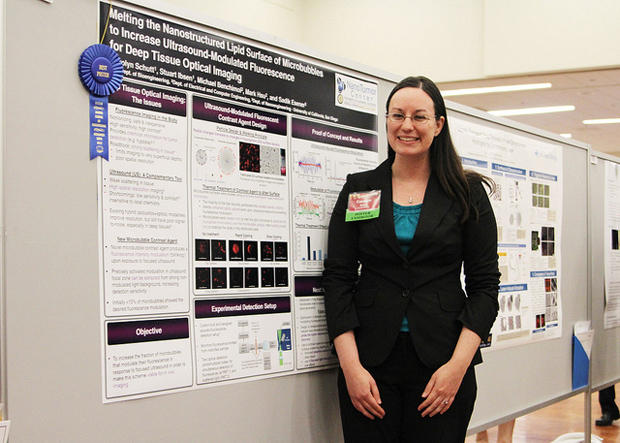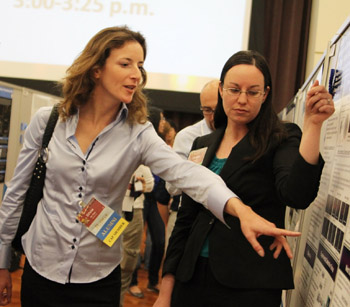
‘Blinking Microbubbles’ for Early Cancer Screening Take Grand Prize at Research Expo 2012
By:
- Catherine Hockmuth
Published Date
By:
- Catherine Hockmuth
Share This:
Article Content

Bioengineering graduate student Carolyn Schutt won the Rudee Outstanding Poster Award for her research into a new imaging technique for breast cancer research. Photo Credit: UC San Diego Jacobs School of Engineering.
Carolyn Schutt, a Ph.D student in bioengineering at the University of California, San Diego is developing a new imaging technique that could lead to highly-sensitive light imaging deeper inside the body, improving the way we diagnose breast cancer. Schutt’s research, which was entered in the nanoengineering category, received the grand prize April 12 at the UC San Diego Jacob School of Engineering Research Expo 2012.
Schutt's aim is to build a bridge between optical imaging and ultrasound imaging, in order to get the benefits of both technologies: the chemical sensitivity of visible light and the tissue penetrating properties of ultrasound. Such a "smart particle contrast agent" would render biological tissue effectively transparent to light and enable highly sensitive light imaging deeper inside the body, improving the way we diagnose cancer. Conventional X-ray mammography can only show the density of tissue, indicating the presence of a mass, but cannot determine any of the biochemical differences between a benign mass and a malignant tumor.
“There is a very high false positive rate with just X-ray mammography,” said Schutt, who was honored with the best poster award for the Department of NanoEngineering and Jacobs School-wide Rudee Outstanding Poster Award. “By being able to extract chemical information we hope to avoid unnecessary biopsies that are done on benign lesions.”
For example, because of their rapid growth, cancerous tumors consume a lot of oxygen so the area around a tumor is likely to be hypoxic or depleted of oxygen. Cancer cells also require increased blood flow to fuel their growth creating a region of new blood vessel formation. The use of this technique could allow this sort of biochemical information to be determined for tumor diagnosis.
Schutt’s work, advised by nanoengineering Professor Sadik Esener, focuses on the use of gas-filled microbubble contrast agents that change their fluorescence intensity, or “blink”, only in response to focused ultrasound. A solution of these microbubbles would be injected into the body to circulate through the blood stream. When gas microbubbles encounter an ultrasound pressure wave, they contract and expand their outer surface in response to the pressure peaks and troughs. By loading the microbubble surface with a fluorescent dye that turns off when it is very close to other dye molecules the ultrasound creates a blinking signal. Initially, less than 10 percent of the bubbles produced this modulating fluorescence. Analysis of the nanostructure by super-resolution microscopy showed that most of the dye partitioned into isolated clusters, which were likely preventing the dye from blinking in response to ultrasound. Schutt was able to manipulate the bubble nanostructure by heating the bubbles to melt their outer surface and distribute the dye more evenly, and then rapidly cooling them to lock in this distributed state. This melting and quick cooling process increased the fraction of blinking microbubbles to over 50 percent, making this a more viable imaging platform.

Schutt (R) discusses her research with judge and alumna Silvia De Dea (L), a staff scientist at Cymer, which is a member of the Jacobs School of Engineering Corporate Affiliates Program. Photo Credit: UC San Diego Jacobs School of Engineering.
This blinking light can then be used to build up an image of the ultrasound-scanned tissue (a suspected tumor, for example) with the sensitivity and contrast offered by optical imaging. This is a new and powerful capability that could significantly improve present diagnostics as well as image guided therapeutic capabilities. In addition to NanoEngineering, Esener is affiliated with the departments of Electrical and Computer Engineering and Computer Science and Engineering, and UC San Diego Moores Cancer Center and director of the multi-institutional NanoTumor Center.
Schutt is also active in campus outreach and leadership programs. As a Gordon Scholar, Schutt participates in the Gordon Engineering Leadership Center’s engineering leadership programs, a course of study Schutt takes seriously. In her current position as outreach chair of the Bioengineering Graduate Student Society, Schutt organized the group’s exhibit at the recent San Diego Festival of Science and Engineering as well as a festival-wide science challenge for K-12 students to learn and discuss key science concepts. Read our chat with Schutt about organizing the Home Run Science Challenge.
Schutt was one of more than 230 graduate students who presented at Research Expo, which was sponsored by Qualcomm, ViaSat and SAIC. Judges were impressed by the students’ high level of technical proficiency and their ability to communicate their ideas.
Three-time Research Expo Judge Silvia De Dea, a staff scientist at Cymer, which is a member of the Jacobs School Corporate Affiliates Program, was impressed by the entrepreneurial mindset of many of the students she met who already had some experience with the patent process, including thinking about how their technology could be eventually sold or licensed to industry. “Realizing that they had that type of mindset was very interesting,” said De Dea, a Jacobs School alumna who earned a master’s (2004) and doctorate (2008) in chemical engineering.
Judge Greg Kusinski, DeepStar Director with Chevron Energy Technology Company, who serves on the Industrial Advisory Board for the Department of NanoEngineering, said the winners demonstrated a unique capacity to explain the relevance of their research. “The students had the ability to present the big picture,” said Kusinski. “That’s why they stood out.” He said that they did a great job at showing the problem they were trying to solve, steps taken during the research process and the next steps in their research.
The grand prize winner was selected from among six individuals or teams representing each of the academic departments at the Jacobs School. The departmental winners are:
NanoEngineering:
Melting the nanostructured lipid surface of microbubbles to increase ultrasound-modulated fluorescence for deep tissue optical imaging
Student(s): Carolyn Elizabeth Schutt
Professor(s): Sadik Esener
Award(s): Rudee Outstanding Award | Department Best Poster
Mechanical and Aerospace Engineering:
Mechanical properties of vascular endothelial cells exposed to stretch
Student(s): Kathryn Elizabeth Osterday | Thomas Chew | Phillip Loury | Manuel Gomez-Gonzalez
Professor(s): Juan Carlos del Alamo
Award(s): Department Best Poster
Structural Engineering:
Non linear aeroelastic analysis of joined wing configurations
Student(s): Rauno Cavallaro
Professor(s): David Benson | Luciano Demasi
Award(s): Department Best Poster | Best Literature Review Award
Electrical and Computer Engineering:
Pixel-by-Pixel contrast-enhanced ultrasound time-intensity curve analysis for automatic tumor diagnosis
Student(s): Casey Nghia Ta
Professor(s): Andrew Kummel
Award(s): Department Best Poster
Bioengineering:
Genome-scale modeling of microbial electrosynthesis for electrofuel production
Student(s): Harish Nagarajan | Juan Nogales | Merve Sahin | Ali Ebrahim | Adam Feist
Professor(s): Bernhard O. Palsson | Karsten Zengler
Award(s): Department Best Poster
Computer Science and Engineering:
Manycore Architecture Augmented for Multiprogrammed Data Centers
Presenter: Anshuman Gupta
Advisor: Michael Taylor
Share This:
You May Also Like
Stay in the Know
Keep up with all the latest from UC San Diego. Subscribe to the newsletter today.


